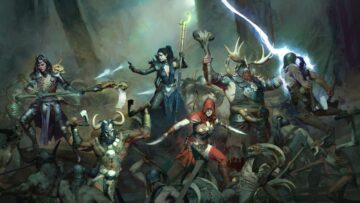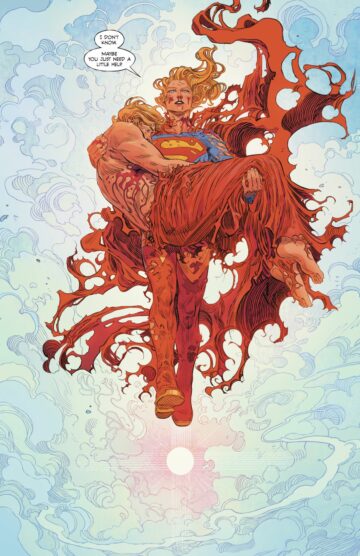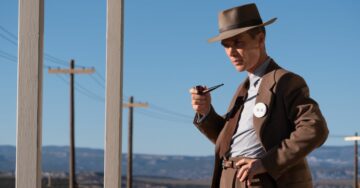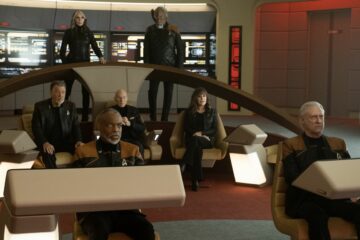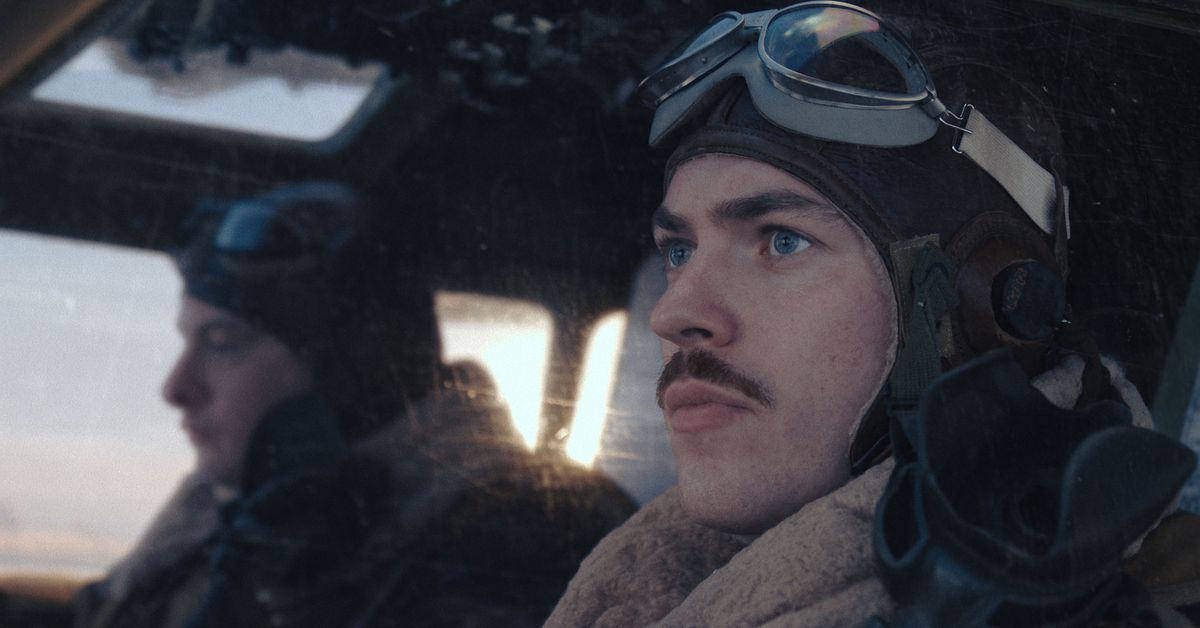
When the A-list cast of Masters of the Air showed up in England in 2021 to begin filming the epic Apple TV Plus miniseries, military consultant Taigh Ramey thought they’d at least know a little something about flying airplanes. But the actors, including stars like Austin Butler and Barry Keoghan, were pretty much clueless about how the iconic B-17 Flying Fortress actually worked.
“None of them had any concept of flying,” Ramey wrote earlier this month on his personal Facebook page, “which was perfectly okay. I had to sit them down in a chair and teach them the very basics of the flight controls and how they are used. Grabbing an imaginary control wheel and had their feet on imaginary rudder pedals. Making sure they used the rudders first and then aileron as you would in a heavy tail wheel aircraft.”
Those first few training sessions, Ramey said, were conducted inside a partial replica of an original B-17 flight deck, delivered to the set by its builder, Dave Littleton. Cobbled together over more than two decades, it included original WWII-era parts and instrumentation. Nate Mann, who plays Maj. Robert “Rosie” Rosenthal, remembers it well.
[embedded content]
“We had a brilliant military advisor in Taigh, who has flown these planes,” Mann told Polygon in a recent interview. “He was with us from start to finish, at first sitting with us in the cockpit, telling us how these gauges worked, how the switches worked.”
After his orientation “flight,” Mann said he took some quality time at home to study. His classroom of choice? The venerable Microsoft Flight Simulator X, a mature platform with several B-17 options to choose from.
Then came the tests.
“[They] tested us on making sure we knew which button did what and when, and when to press it and how to do it,” Callum Turner told Polygon. “They were meticulous with that. And that was actually something that really helped us bond, because there was a competitive spirit to that and no one wanted to be the worst. I don’t think anyone really cared about being the best, they just didn’t wanna be the worst.”
From there, the team was ready for their final on-screen flights inside the Volume. The crew of Masters of the Air invested in the same kind of live-action digital film set that helped bring to life The Mandalorian, but with one big difference. Inside the ring of high-definition digital “content walls” where the backgrounds of these battle scenes would play out, they built a full-scale replica of the forward B-17 crew compartment, from the bombardier’s station in the very front of the plane to the radio operator in the rear. They plopped it all on top of a 50-foot-tall hydraulic arm, and then programmed it to put the actors through the wringer.
“We would shoot a sequence and there might be six cameras filming it at any given time,” Mann said. “They would call cut, and Taigh would come on the walkie. […] This time flip this switch instead of that one, because that’s going to disengage this. This is the feathering sequence for this engine, etc.
“What that does as a performer is just keep your attention out,” Mann continued. “Especially when you’re masked […] and only your eyes are visible, to get the tactile sort of immersive quality of it takes you so far out of yourself that you’re really just trying to live through it, rather than perform, or guess at the experience of flying.”
Turner, who plays Maj. John “Bucky” Egan, said the elaborate rig, when combined with the digital content inside the Volume, was integral to his performance.
“The Volume is just this extraordinary experience, because you don’t act,” Turner said. “You’re just living, and being, and breathing, and exploring the journey as it comes to you. And you can see it, and you can feel it. The days of green screen have probably gone with this technology. […] They gave us everything to succeed. It was really a wonderful, wonderful thing to have.”
The result is an impeccable blend of computer generated imagery, old-school prop-making, modern set design, and visceral human emotion — which you can see in this exclusive clip, starring Mann as Maj. Rosenthal from episode 5.
Masters of the Air is now streaming on Apple TV Plus.
- SEO Powered Content & PR Distribution. Get Amplified Today.
- PlatoData.Network Vertical Generative Ai. Empower Yourself. Access Here.
- PlatoAiStream. Web3 Intelligence. Knowledge Amplified. Access Here.
- PlatoESG. Carbon, CleanTech, Energy, Environment, Solar, Waste Management. Access Here.
- PlatoHealth. Biotech and Clinical Trials Intelligence. Access Here.
- Source: https://www.polygon.com/24073247/masters-air-volume-msfs-flight-sim-rig
- :has
- :is
- :where
- $UP
- 5
- a
- A-List
- About
- Act
- actors
- actually
- advisor
- AIR
- aircraft
- Airplanes
- All
- an
- and
- any
- anyone
- Apple
- apple tv
- ARE
- ARM
- AS
- At
- attention
- austin
- backgrounds
- barry
- Basics
- Battle
- BE
- because
- begin
- being
- BEST
- Big
- Blend
- bond
- breathing
- brilliant
- bring
- builder
- built
- but
- button
- by
- call
- came
- cameras
- CAN
- Chair
- choice
- Choose
- classroom
- Cockpit
- combined
- come
- comes
- competitive
- computer
- concept
- conducted
- consultant
- content
- continued
- control
- controls
- course
- crew
- Cut
- Dave
- Days
- decades
- deck
- delivered
- Design
- DID
- difference
- digital
- Digital Content
- do
- does
- Dont
- down
- Earlier
- Elaborate
- embedded
- emotion
- England
- EPIC
- episode
- etc
- everything
- Exclusive
- experience
- Exploring
- extraordinary
- Eyes
- far
- feel
- Feet
- few
- Film
- filming
- final
- finish
- First
- flight
- Flights
- Flip
- flying
- For
- Fortress
- Forward
- from
- front
- full-scale
- gave
- generated
- get
- given
- going
- gone
- Green
- guess
- had
- Have
- he
- heavy
- helped
- high-definition
- his
- Home
- How
- How To
- HTTPS
- human
- i
- iconic
- imaginary
- immersive
- in
- included
- Including
- inside
- instead
- integral
- Interview
- invested
- IT
- ITS
- John
- journey
- jpg
- just
- Keep
- Kind
- Know
- least
- Life
- like
- live
- living
- Making
- mature
- meticulous
- Microsoft
- might
- Military
- Modern
- Month
- more
- much
- no
- now
- of
- Okay
- on
- ONE
- only
- operator
- Options
- or
- original
- out
- over
- partial
- parts
- perfectly
- perform
- performance
- performer
- personal
- plane
- Planes
- platform
- plato
- Plato Data Intelligence
- PlatoData
- Play
- plays
- plus
- Polygon
- press
- pretty
- probably
- programmed
- put
- quality
- Radio
- rather
- ready
- really
- recent
- replica
- result
- rig
- Ring
- ROBERT
- Said
- same
- scenes
- Screen
- see
- Sequence
- sessions
- set
- several
- Shoot
- showed
- simulator
- sit
- Sitting
- SIX
- So
- so Far
- some
- something
- spirit
- Stars
- start
- station
- streaming
- Study
- succeed
- sure
- Switch
- takes
- team
- Technology
- telling
- tested
- tests
- than
- that
- The
- their
- Them
- then
- There.
- These
- they
- thing
- Think
- this
- thought
- Through
- time
- to
- together
- told
- tom
- took
- top
- Train
- Training
- trying
- tv
- two
- us
- used
- very
- visceral
- visible
- volume
- wanted
- was
- we
- WELL
- were
- What
- Wheel
- when
- which
- WHO
- with
- wonderful
- worked
- Worst
- would
- wrote
- you
- Your
- yourself
- youtube
- zephyrnet



